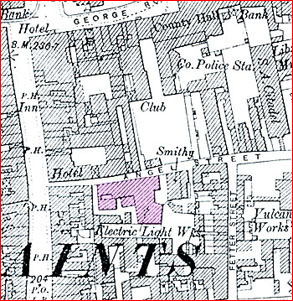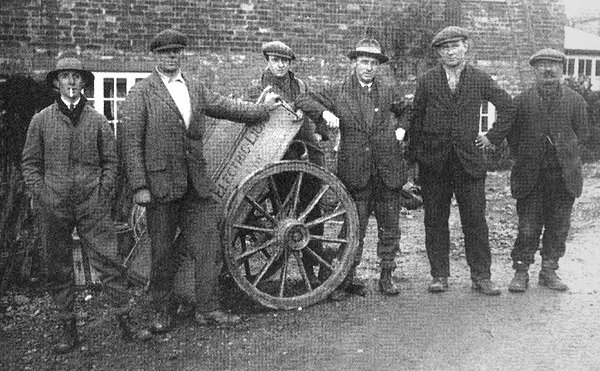|
Blisworth's Electrification Tony Marsh* December 2014
An important issue in the early part of the century was the government’s push towards better health and they introduced the 1924 and 1930 Ministry of Housing Acts. These acts were aimed to improve conditions in housing, especially the more modest housing. Electricity was brought in to Blisworth on overhead wires in 1927. This was following a logical sequence: from the village of Roade, with its substantial demand by its factories, followed by Courtenhall, Collingtree, Milton and Blisworth and on to Tiffield and Towcester.
Both the grandfather and father of Stan Clark (footnote below) worked for the NELPC at Angel Lane and the father, Walter, headed the gang that came to Blisworth. He is second from the left in the picture above. Apparently life in the village was transformed although the basic supply was for one power point and five lights. Some people paid to have extra and this facility was extended to as late as 1937 by the power company. According to Stan Clark, George Freeston remembered that there were several changes in the shop (Post Office) next to their High Street garage. One was the heavy slump in the sales of paraffin and candles, along with boxes of matches, and bundles of spills, all of these being basic commodities, once the electricity was installed within the village.
The picture above show a typical pole gang - they are wearing standard boots. The linesmen who connected the wires from pole to pole did it live with the power running through the wires and they always wore stout wellington boots as there was no convenient way of switching the power off without causing problems with what was already installed. Wealthy folk would have the power delivered to a meter within their homes so that they could pay quarterly for the amount used. The standard, however, was to have a shilling meter with a slot, so as they could pay as they used it and rely on an area employee who read those with meters and collected coins from others. Certain owners may not have bothered with the offered paltry connection in 1927. For example the 1879 corn mill may have been using its own steam powered electric generator. The village took up the use of electricity with some alacrity led, probably, by the school which was connected on November 11th, 1927. In November three years later the school acquired an electric cooker for the kitchen. In January 1931 the staff started offering hot drinks at lunchtime for the chidren. By May 1933 the head had acquired a projection lantern and gave the first of many educational lantern lectures - the first covered the benefits to the British Empire of our "ownership" of African territory. No doubt in order to promote better communications (we now call networking) the BBC visited the school and installed in 1938 a government issue radio set which "was carefully checked". Some time in 1939 another BBC employee paid a visit to the school to check radio reception, clearly in anticipation of war. Through the decades, especially after the WWII, the NELPC was subsumed by a County electricity authority and subsequently merged with the UK wide Central Electricity Generating Board (CEGB) which saw the assembly of the electricity grid as we now recognise it. In villages such as ours there remained plenty of reminders of the overhead distribution and the inter-house wiring on the facing walls of adjacent semi-detached houses. The last area to be tidied up and placed underground was the wiring in Stoke Road in 2012. * Stanley Joseph Clark - although living in Bugbrooke he is familiar with Blisworth because of family relatives in Stoke Road (Gibbs and French) and was a friend of George Freeston. He provided the "gang" picture and much detail and anecdotes on the 1927 installations. |


 There were serious shortages in those years. Due
to the political problems within Russia, reports Stan Clark, the poles
needed to carry the electricity wires were in short supply, hence some
prefabricated concrete poles were used instead. Some of the steel poles
that once carried the overhead wires for the trams within Northampton
with arms that once carried wires for the trams, were used to hang
street lights on. (not in Blisworth as far as is known) The shortage of poles had another effect;
father was paid bonuses if he could get folk to accept the power run
from house to house instead of using poles as long as the necessary
brackets could be securely fixed to the walls. Occasionally the residual brackets
can still be found. Their use was soon banned from the
installer's code since in some cases the weight of ice on overhead
cables pulled walls over. The early poles were very tall and were
finished at the top with a distinctive finial (see inset) but they
rotted and by the 1970s were either replaced or removed as some wiring
was placed underground.
There were serious shortages in those years. Due
to the political problems within Russia, reports Stan Clark, the poles
needed to carry the electricity wires were in short supply, hence some
prefabricated concrete poles were used instead. Some of the steel poles
that once carried the overhead wires for the trams within Northampton
with arms that once carried wires for the trams, were used to hang
street lights on. (not in Blisworth as far as is known) The shortage of poles had another effect;
father was paid bonuses if he could get folk to accept the power run
from house to house instead of using poles as long as the necessary
brackets could be securely fixed to the walls. Occasionally the residual brackets
can still be found. Their use was soon banned from the
installer's code since in some cases the weight of ice on overhead
cables pulled walls over. The early poles were very tall and were
finished at the top with a distinctive finial (see inset) but they
rotted and by the 1970s were either replaced or removed as some wiring
was placed underground.